What is Soy?
Soy can be found in a number of products. The soybean offers a complete protein profile, making it a good substitute for animal protein. For years, vegetarians and health enthusiasts have known that foods rich in soy protein offer a great alternative to meat, poultry, and other animal-based products. As consumers have pursued healthier lifestyles in recent years, consumption of soy foods has risen steadily, bolstered by scientific studies showing health benefits from soy products.
In 1999, the Food and Drug Administration (FDA) allowed food manufacturers to label foods high in soy protein as products that may help lower the risk of heart disease.
Soy allergies are most common in young children and usually outgrown by age three. Soy allergies may, however, persist into adulthood.
Soy Allergy Symptoms
Symptoms from an allergy to soy may include (but are not limited to): urticaria (hives), eczema, tingling of the lips, tongue, or throat, itching, wheezing, nausea, vomiting, abdominal pain, dizziness, fainting, and anaphylaxis. Anaphylaxis may include all of the symptoms mentioned as well as difficulty breathing and reduced blood pressure, which can be life-threatening. This needs to be addressed as a medical emergency; call 911 immediately.
How Can It Be Managed?
The most effective way to prevent an allergic reaction to soy products is to avoid soy and soy proteins entirely. Although antihistamines can reduce the discomfort associated with symptoms of soy allergies, there is no treatment that prevents allergic reactions to soy.
Since soy is one of the top eight allergens, the FDA requires any food that contains soy or a soy product display a food allergy warning on the ingredients list of the respective product. If you have a soy allergy or know someone who does, make sure to check ingredient labels frequently because product formulations can change. Checking the ingredients on the label each time is the best way to prevent an allergic reaction.
Below are two ways soy can be called out on the label. (Bold is used for illustrative purposes only):
Label 1
INGREDIENTS:
Whole Grain Wheat, Sugar, Raisins, Almond Pieces, Corn Bran, Partially Hydrogenated Cottonseed Oil, Corn Syrup, Glycerin, Brown Sugar Syrup, Salt, Soy Lecithin, Natural and Artificial Flavor
CONTAINS: Wheat, Almond, Soy
Label 2
INGREDIENTS:
Whole Grain Wheat, Sugar, Raisins, Almond Pieces, Corn Bran, Partially Hydrogenated Cottonseed Oil, Corn Syrup, Glycerin, Brown Sugar Syrup, Salt, Soy Lecithin (Soy), Natural and Artificial Flavor
It is also a good idea to investigate unexpected sources of soy in foods you eat in order to prevent potential allergic reactions.
Types of Soy Products:
- Hydrolyzed plant protein
- Hydrolyzed vegetable protein
- Miso
- Natural flavoring
- Soy (flour, grits, nuts, milk, sprouts)
- Soya flour
- Soybean (granules, curd)
- Soy protein (concentrate, hydrolyzed, isolate)
- Soy sauce
- Shoyu sauce
- Tamari
- Tempeh
- Textured vegetable protein (TVP)
- Tofu
Potential Unexpected Soy Products:
- Baked goods
- Candies
- Canned tuna
- Cereals
- Crackers
- Gravies
- Infant formulas
- Sauces
- Soups
- Soy nut butter or sunflower seed butter
- Vegetable broth
- Vegetable protein concentrate
- Vegetable starch
- Worcestershire sauce
Keep in mind that it’s always best to contact the manufacturer with your ingredient questions before eating or serving these products to customers or patients. Manufacturers have the most up-to-date information regarding ingredient changes and the manufacturing process, which can help you avoid potential adverse reactions to soy and soy products.
Are you a Gordon Food Service customer? Log into Gordon Experience to view additional resources, such as food allergen awareness topics and training.
Additional allergen information regarding soy can be found in the following areas:
- Gordon Food Service Family of Brands Ingredient Statements
- Food Allergy Research and Education











